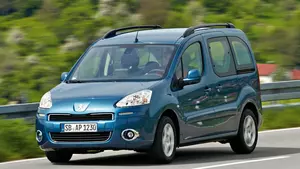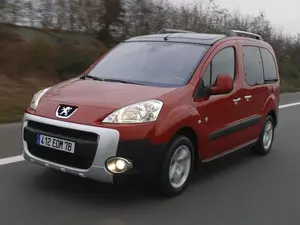
| Vehicle | Curb weight | Difference from world's smallest | Weight to power ratio | 0—60 mph acceleration ratio | Consumption ratio |
|---|---|---|---|---|---|
| 1.6 BlueHDi |
1320 kg / 2911 lbs |
895 kg (1974 lbs) heavier | 13 kg to 1 hp | 111 kg/s (245 lbs/s) |
314 kg/L (692 lbs/L) |
| 1.5 BlueHDi |
1380 kg / 3043 lbs |
955 kg (2106 lbs) heavier | 11 kg to 1 hp | 135 kg/s (298 lbs/s) |
321 kg/L (708 lbs/L) |
| Vehicle | 1.6 BlueHDi |
|---|---|
| Curb weight |
1320 kg / 2911 lbs |
| Difference from world's smallest | 895 kg (895 lbs) heavier |
| Weight to power ratio | 13 kg to 1 hp |
| 0—60 mph acceleration ratio | 111 kg/s (245 lbs/s) |
| Consumption ratio |
314 kg/L (692 lbs/L) |
| Vehicle | 1.5 BlueHDi |
| Curb weight |
1380 kg / 3043 lbs |
| Difference from world's smallest | 955 kg (955 lbs) heavier |
| Weight to power ratio | 11 kg to 1 hp |
| 0—60 mph acceleration ratio | 135 kg/s (298 lbs/s) |
| Consumption ratio |
321 kg/L (708 lbs/L) |

| Vehicle | Curb weight | Difference from world's smallest | Weight to power ratio | 0—60 mph acceleration ratio | Consumption ratio |
|---|---|---|---|---|---|
| 1.6 BlueHDi |
1395 kg / 3076 lbs |
970 kg (2139 lbs) heavier | 14 kg to 1 hp | 116 kg/s (256 lbs/s) |
324 kg/L (714 lbs/L) |
| 1.5 BlueHDi |
1430 kg / 3153 lbs |
1005 kg (2216 lbs) heavier | 11 kg to 1 hp | 138 kg/s (304 lbs/s) |
333 kg/L (734 lbs/L) |
| Vehicle | 1.6 BlueHDi |
|---|---|
| Curb weight |
1395 kg / 3076 lbs |
| Difference from world's smallest | 970 kg (970 lbs) heavier |
| Weight to power ratio | 14 kg to 1 hp |
| 0—60 mph acceleration ratio | 116 kg/s (256 lbs/s) |
| Consumption ratio |
324 kg/L (714 lbs/L) |
| Vehicle | 1.5 BlueHDi |
| Curb weight |
1430 kg / 3153 lbs |
| Difference from world's smallest | 1005 kg (1005 lbs) heavier |
| Weight to power ratio | 11 kg to 1 hp |
| 0—60 mph acceleration ratio | 138 kg/s (304 lbs/s) |
| Consumption ratio |
333 kg/L (734 lbs/L) |

| Vehicle | Curb weight | Difference from world's smallest | Weight to power ratio | 0—60 mph acceleration ratio | Consumption ratio |
|---|---|---|---|---|---|
| 22.5 kWh |
1794 kg / 3956 lbs |
1369 kg (3019 lbs) heavier | 27 kg to 1 hp | 97 kg/s (214 lbs/s) | - |
| Vehicle | 22.5 kWh |
|---|---|
| Curb weight |
1794 kg / 3956 lbs |
| Difference from world's smallest | 1369 kg (1369 lbs) heavier |
| Weight to power ratio | 27 kg to 1 hp |
| 0—60 mph acceleration ratio | 97 kg/s (214 lbs/s) |
| Consumption ratio | - |

| Vehicle | Curb weight | Difference from world's smallest | Weight to power ratio | 0—60 mph acceleration ratio | Consumption ratio |
|---|---|---|---|---|---|
| 1.6 HDi |
1435 kg / 3164 lbs |
1010 kg (2227 lbs) heavier | 16 kg to 1 hp | 106 kg/s (234 lbs/s) |
276 kg/L (609 lbs/L) |
| 1.6 VTi |
1395 kg / 3076 lbs |
970 kg (2139 lbs) heavier | 12 kg to 1 hp | 122 kg/s (269 lbs/s) |
196 kg/L (432 lbs/L) |
| Vehicle | 1.6 HDi |
|---|---|
| Curb weight |
1435 kg / 3164 lbs |
| Difference from world's smallest | 1010 kg (1010 lbs) heavier |
| Weight to power ratio | 16 kg to 1 hp |
| 0—60 mph acceleration ratio | 106 kg/s (234 lbs/s) |
| Consumption ratio |
276 kg/L (609 lbs/L) |
| Vehicle | 1.6 VTi |
| Curb weight |
1395 kg / 3076 lbs |
| Difference from world's smallest | 970 kg (970 lbs) heavier |
| Weight to power ratio | 12 kg to 1 hp |
| 0—60 mph acceleration ratio | 122 kg/s (269 lbs/s) |
| Consumption ratio |
196 kg/L (432 lbs/L) |

| Vehicle | Curb weight | Difference from world's smallest | Weight to power ratio | 0—60 mph acceleration ratio | Consumption ratio |
|---|---|---|---|---|---|
| 1.6 |
1397 kg / 3080 lbs |
972 kg (2143 lbs) heavier | 16 kg to 1 hp | 88 kg/s (194 lbs/s) |
170 kg/L (375 lbs/L) |
| 1.6 HDi |
1407 kg / 3102 lbs |
982 kg (2165 lbs) heavier | 19 kg to 1 hp | 87 kg/s (192 lbs/s) |
247 kg/L (545 lbs/L) |
| Vehicle | 1.6 |
|---|---|
| Curb weight |
1397 kg / 3080 lbs |
| Difference from world's smallest | 972 kg (972 lbs) heavier |
| Weight to power ratio | 16 kg to 1 hp |
| 0—60 mph acceleration ratio | 88 kg/s (194 lbs/s) |
| Consumption ratio |
170 kg/L (375 lbs/L) |
| Vehicle | 1.6 HDi |
| Curb weight |
1407 kg / 3102 lbs |
| Difference from world's smallest | 982 kg (982 lbs) heavier |
| Weight to power ratio | 19 kg to 1 hp |
| 0—60 mph acceleration ratio | 87 kg/s (192 lbs/s) |
| Consumption ratio |
247 kg/L (545 lbs/L) |

| Vehicle | Curb weight | Difference from world's smallest | Weight to power ratio | 0—60 mph acceleration ratio | Consumption ratio |
|---|---|---|---|---|---|
| 1.4 |
1190 kg / 2624 lbs |
765 kg (1687 lbs) heavier | 16 kg to 1 hp | 72 kg/s (159 lbs/s) |
159 kg/L (351 lbs/L) |
| 1.6 HDi |
1407 kg / 3102 lbs |
982 kg (2165 lbs) heavier | 16 kg to 1 hp | 118 kg/s (260 lbs/s) |
261 kg/L (576 lbs/L) |
| 1.6 |
1250 kg / 2756 lbs |
825 kg (1819 lbs) heavier | 11 kg to 1 hp | 101 kg/s (223 lbs/s) |
169 kg/L (373 lbs/L) |
| 1.9 D |
1265 kg / 2789 lbs |
840 kg (1852 lbs) heavier | 18 kg to 1 hp | 65 kg/s (143 lbs/s) |
183 kg/L (404 lbs/L) |
| 2.0 HDi |
1310 kg / 2889 lbs |
885 kg (1952 lbs) heavier | 15 kg to 1 hp | 89 kg/s (196 lbs/s) |
226 kg/L (498 lbs/L) |
| Vehicle | 1.4 |
|---|---|
| Curb weight |
1190 kg / 2624 lbs |
| Difference from world's smallest | 765 kg (765 lbs) heavier |
| Weight to power ratio | 16 kg to 1 hp |
| 0—60 mph acceleration ratio | 72 kg/s (159 lbs/s) |
| Consumption ratio |
159 kg/L (351 lbs/L) |
| Vehicle | 1.6 HDi |
| Curb weight |
1407 kg / 3102 lbs |
| Difference from world's smallest | 982 kg (982 lbs) heavier |
| Weight to power ratio | 16 kg to 1 hp |
| 0—60 mph acceleration ratio | 118 kg/s (260 lbs/s) |
| Consumption ratio |
261 kg/L (576 lbs/L) |
| Vehicle | 1.6 |
| Curb weight |
1250 kg / 2756 lbs |
| Difference from world's smallest | 825 kg (825 lbs) heavier |
| Weight to power ratio | 11 kg to 1 hp |
| 0—60 mph acceleration ratio | 101 kg/s (223 lbs/s) |
| Consumption ratio |
169 kg/L (373 lbs/L) |
| Vehicle | 1.9 D |
| Curb weight |
1265 kg / 2789 lbs |
| Difference from world's smallest | 840 kg (840 lbs) heavier |
| Weight to power ratio | 18 kg to 1 hp |
| 0—60 mph acceleration ratio | 65 kg/s (143 lbs/s) |
| Consumption ratio |
183 kg/L (404 lbs/L) |
| Vehicle | 2.0 HDi |
| Curb weight |
1310 kg / 2889 lbs |
| Difference from world's smallest | 885 kg (885 lbs) heavier |
| Weight to power ratio | 15 kg to 1 hp |
| 0—60 mph acceleration ratio | 89 kg/s (196 lbs/s) |
| Consumption ratio |
226 kg/L (498 lbs/L) |